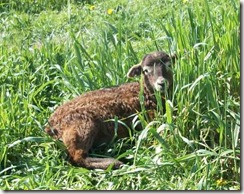Here is the fourth section of my notes on grass. Needless to say, I took a LOT of notes during Woody Lane’s lecture…
Estimating Your Grass Volume
So, I’ve talked about Woody’s assertion that you can’t just go by grass height when planning rotational grazing, because you need to be sure your animals can eat what’s in their square in five days or less. So, what you ultimately must learn to do is train your eye to estimate the total mass (weight) of grass you have in your field. Then you can calculate how long it will take your animals to eat it and leave a proper reserve behind to support optimal Phase 2 re-growth.
To train your eye, Woody recommends spending some time actually taking samples of your grass and weighing them. His method is straightforward: snip a small sample square of grass, right down to the base, put it in a paper bag in the microwave (with a glass of water to absorb some of the energy, and he warns to change that frequently, as it’ll get quite hot). Zap it for a couple of minutes at a time. Weigh it using a postal scale that measures in grams, after ever 2 minutes in the microwave, until it stops losing weight, then you know it’s dry: now it’s dry matter weight, see?
His method of converting this weight to pounds per acre is slick: when you cut your sample of grass, cut an 11.5×12” rectangle. Weigh it in grams, add two zeros, and bingo, you have pounds per acre. Cool, huh? I had to look up the conversion factors to verify it for myself, but look, it really works:
Remember your junior high algebra? If I measure 1 gram of grass in an 11.5×12 rectangle, that’s 138 square inches. If I multiple that times the conversion of square inches to acres, I’m canceling out the square inches unit, so I have grams per acre. If I multiple again times the conversion of grams to lbs, I’m canceling out the grams unit. This leaves me with a unit of lbs/acre, and lo and behold, it’s (roughly) 100! So, for the 1 gram I measured, add two zeros, and I have my feed volume estimate in units I can work with.
“Right-Sizing” Grazing Sections
Now we have all the math we need. Sheep eat (and trample) about 5% of their body mass per day in grass hay. So, a 150lb ewe needs 7.5 lbs per day of dry matter feed with middle-of-the-road TDN values. Figure out how many pounds your flock will eat in five days, and then size a rectangle appropriately to match that based on how many pounds per acre you have estimated in your field at a given time (remembering to calculate for leaving some grass behind for re-growth!).
Woody advises running one long hotwire transmission line down the middle (or end) of your field. From that, you can hook up portable hotwire to any place along that wire, so that you can flexibly re-size your rectangles on a continual basis during different parts of the growing season.
True MIG
This is what Woody feels is the true meaning of “Management Intensive Grazing” or MIG. The key is, it’s not “intensive grazing” (meaning grazing intensively) but rather “management intensive” (meaning that you manage it intensively). This method is far and above the generic theory of “pasture rotation” that we read about in many places; and you can see why Woody started out his talk saying “pasture rotation doesn’t work.”
This whole explanation really makes a lot of sense to me and addresses many of the problems I’ve had in starting to do rotational grazing. This spring I felt like even moving the sheep daily was cruelly butchering the grass, which had barely had a chance to gain any ground. I think I put them out there while the poor grass was still in Phase 1, which probably delayed my good Phase 2 growing season by weeks. I should have kept them in a sacrifice area and fed them hay longer, until I had more volume of grass to start out with.
Later in the summer, we had too much grass for the number of sheep we had, they couldn’t keep up. I left them in a square for two weeks or more, but could see that they were eating the re-growth, while leaving other taller stands of grass alone (or trampling them). Doh! They were not evenly grooming the square like I planned! So I need to do smaller squares during the “lush” season.
I ended up doing a lot of mowing to groom grass behind the sheep, and to keep the overall growth down, since the sheep couldn’t eat it fast enough. Mowing (or ideally cutting hay or haylage) is the other component of pasture management. When you don’t have the right number of animals to eat it all, you have to keep it from seeding out midseason with mechanical means. Mowing was also necessary when the grass got longer, to keep my portable hotwire from shorting out too much, I would mow swaths for the fence path. But the whole point of having the sheep is to replace mowing, so I really want to get pasture rotation working for me!
Next time, I’m going to address the last topic on grass, which was a lunch-table discussion I had with Woody and another Expo attendee on Reed Canary Grass or RCG.

